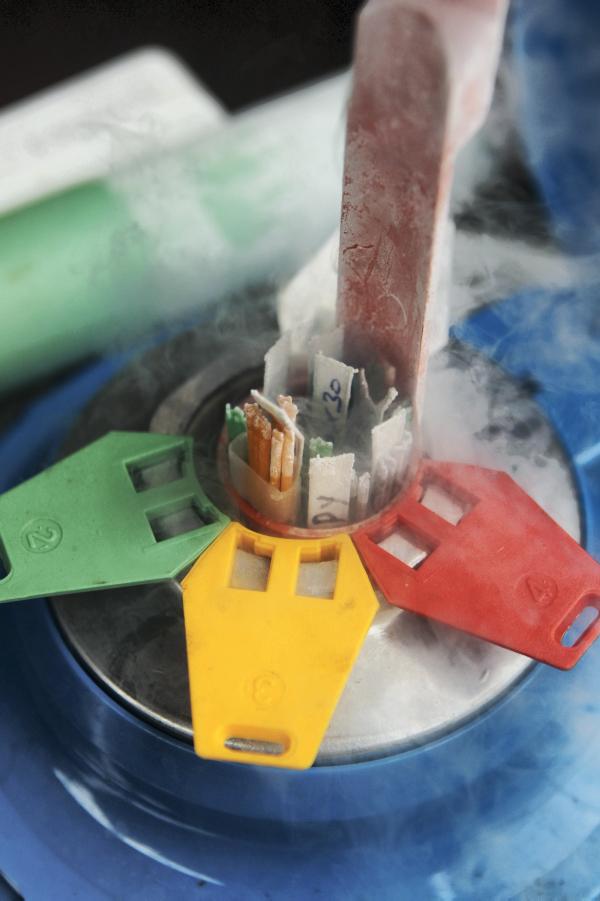Many farmers around the country have chosen to carry out AI themselves on their own farms. In some cases, it is due to the volume of inseminations required, in others it is to have more control over the timing of insemination.
Although most farmers are in their own set routine, it is no harm to recap on some of the main points. Firstly, for those who are thinking about doing DIY AI, look at the cost. For small herds, its simply un-economical. To do the AI course required by the Department of Agriculture will cost over €500. The AI flask can vary in price, but will be at least another €500. The costs don’t stop there – liquid nitrogen contracts to fill the pot four times a year start at about €200.
Although there may be perceived benefits to the DIY option, the AI man may still be the best option for smaller herds.
Semen is sensitive to temperature changes. Straws should be kept submerged in liquid nitrogen at all times if possible. It is advisable to always use tweezers for handling straws. Picking them up with your fingers will allow heat to travel to the straw, which could potentially be damaging to the semen.
Some farmers will have a diagram detailing what straws are stored where in the AI flask. This reduces handling of straws and the risk of damage. The small canisters containing the straws should be full with liquid nitrogen when the larger canister has been removed.
Some people puncture holes in the bottoms of the small canisters to ensure they don’t float. However, it is more beneficial to ensure that the small plastic canisters are packed tightly and are full with liquid nitrogen. This helps to keep straws cool when removed into the neck of the flask.
It is best practice when removing a straw to ensure that canister is not lifted out into the neck of the flask for more than 10 seconds at a time. If it takes more than eight seconds to locate an AI straw in the canister, then the canister should be dropped back down into the liquid nitrogen to cool for a period of 30 seconds before lifting again.
Thawing straws
When the goblet is lifted to within 1-2in of the top of the neck of the flask, the required straw should be removed with a tweezers within 10 seconds, the goblet should be lowered back into the flask and the lid put in place.
It is best practice to shake the straw to ensure all liquid nitrogen is removed and then place it in a thawing flask with the water at 33-36°C. Higher or lower temperatures may damage the semen in the straw. A thermometer should be used to accurately assess the temperature of the water.
Once it is in the thawing flask, you should leave it 50-60 seconds before placing it in the gun. Once the straw is removed from the thawing flask, it should be dried using a paper towel before placing it in the gun. It is advisable, particularly in cold weather, to warm the AI gun while keeping it dry in order to avoid the temperature of the straw dropping before the cow is served.
The semen should be placed in the cow, ideally within five minutes of thawing. The straw needs to be kept from 33-36°C between loading and insemination.
Hygiene
When removing a sheath from the pack, only touch the bottom end of it. It is crucial that no dirt or bacteria is on the tip of the sheath at insemination.
The cow should be wiped with a paper towel to ensure there is no dirt on the opening of the vagina. Sheath covers are thin plastic films that can be used to cover the sheath and keep the sheath clean as it enters the cow.
Once you have started to insert the AI gun, you can push the sheath through the end of the sheath cover; this ensures that the plastic sheath is free of harmful dirt.
Maintaining the flask
An AI flask is insulated to store liquid nitrogen which is used to keep AI straws frozen at -196°C. As an AI flask ages, it can lose some of its insulative capacity. As a result, the liquid nitrogen may be lost at a faster rate.
Usually AI flasks are topped up every three months, or four times per year. Tanks should be stored in a cool, dry place out of direct sunlight.
Ideally, place the AI flask on a timber board or pallet and not on a wet concrete floor.
The nitrogen level should be checked at regular intervals to avoid it running dry as straws can be lost. It should be checked often during the main usage time in spring and autumn, as opening and closing will result in more losses of liquid nitrogen.
When AI flasks are not in use, they should continue to be kept topped up with liquid nitrogen. Allowing the flask to go dry when not in use can damage the insulative capacity of the flask in the long term.






 This is a subscriber-only article
This is a subscriber-only article










SHARING OPTIONS: